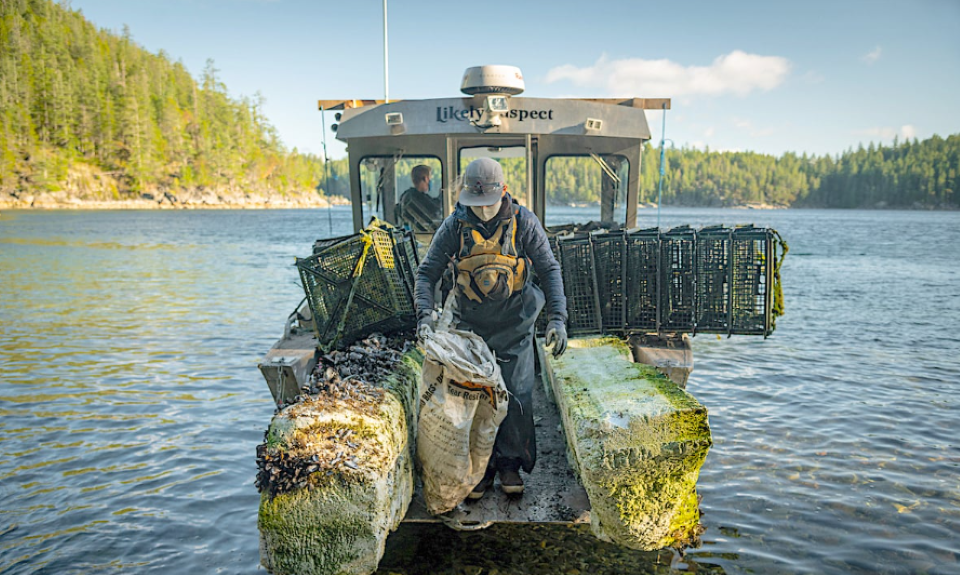Light, buoyant and cheap, polystyrene foam is commonly used for docks, buoys, pontoons at marinas and other water activities throughout Canada.
But the plastic, oil-based product is causing a wave of pollution in oceans and waters across the country, says B.C. NDP MP Rachel Blaney.
The federal government needs to ban the use of expanded polystyrene (ESP) and extruded polystyrene (XP), commonly known as Styrofoam, in floating structures in both freshwater and saltwater, said Blaney, the MP for North Island-Powell River.
Polystyrene foam never breaks down, but degrades into thousands of small puffed plastic fragments that travel long distances and are extremely hazardous to aquatic environments, she said.
“It’s just so harmful to our beaches, fish in the ocean and to wildlife on the shores,” Blaney said, adding polystyrene foam is a top complaint from communities in her riding involved in coastal cleanups.
“As it breaks into those smaller and smaller microbeads, it's absolutely impossible to clean up,” she said.
“It's crazy to think in this country that we're putting foam into the water purposefully — we shouldn't be doing that.”
Blaney has tabled a motion to ban the use of polystyrene foams to build floating structures and phase out their use in existing ones and has partnered with ocean conservation groups, including Surfrider Canada, on a letter-writing campaign supporting the ban.
The federal government included Styrofoam takeout containers when it launched the phaseout of six single-use plastic items in December, Blaney noted.
“But there’s just so much more that they could do,” she said, adding it’s not just a coastal issue.
“It’s everywhere. Communities across Canada that are inland are having their lakes, rivers and waterways being polluted.”
After Blaney submitted a petition to Parliament in the summer calling for a ban, the federal government said it wasn’t looking at prohibiting polystyrene foam in marine ecosystems. However, Environment Minister Steven Guilbeault noted Fisheries and Oceans Canada (DFO) had new regulations obliging shellfish growers to encase any foam floats in hard plastic shells.
Blaney said while the government doesn’t see the need for further action, coastal communities do.
“We see the need,” she said. “I see it all the time in my constituency on the beaches and in the water, so that doesn’t work for me.”
Banning foam floats a 'no-brainer'
Banning the use of polystyrene foam in aquatic infrastructure is a quick and relatively easy way to make a positive impact on marine ecosystems, said Peter Ross, senior scientist and director of water pollution at the Raincoast Conservation Foundation.
“It’s an easy fix, especially when there are alternative materials available. It should be a no-brainer,” Ross said.
The degradation of foam, either over time or set loose by stormy weather, is a chronic source of pollution and causes harm to animals that feed along the shore or on the surface of the water, like birds, fish, turtles and even marine mammals feeding or coming up for air, he said. This can lead to starvation or blockages that can eventually kill an animal, he said.
“These microplastics float, which is a little bit different than many other plastics,” he said.
“When you’ve got these tiny white things floating around, many, many species are going to mistake them for food.”
And if the plastic foam beads are “biofouled” — darkened and covered with algae, bacteria, plankton or other organic matter after being in the water for an extended period of time — it’s going to mimic food to an even greater degree, Ross added.
“Then it really starts to resemble, and even taste, like natural food,” he said.
“It really brings up the risk of surreptitious consumption by some poor creature that thinks it’s actually something nutritious.”
Stopping the flow of plastics before they enter waterways and oceans is the most effective way to tackle the scope of the problem, Ross said, adding technology and cleanups can’t keep pace with the amount of pollution entering the ocean.
Foam pollution demoralizing for cleanup volunteers
Quadra Island resident Nevil Hand, who organizes regular beach cleanups in his community, agreed.
Large or small, cleaning up foam is especially difficult, said the retired firefighter who organizes the Quadra Island Beach Clean Dream Team.
In November, community volunteers cleaned up the island’s beaches, and within a month, winter storms had erased any sign the teams had been there, he said.
“This winter, it seemed like an entire marina exploded to the south of us,” he said.
“We've got big pieces of dock flotation here this year in amounts we’ve never seen before.”
Clean team volunteers, now holding a spring cleanup contest, have been stacking up foam debris at beach trailheads for pick up, Hand said, adding it’s unsettling to see how much there is.
“Foam is so fragile. It’s disgusting the way it breaks up so easily along our shores,” he said.
Some volunteers just found a 12-foot-long piece of foam that they hope will dry out in the coming weeks so they can remove it.
“The problem is we can only really deal with the bigger pieces,” he said.
“Even then, when we’re handling it, it’s breaking up in our hands and we’re making even more of a mess.”
It’s demoralizing because the small pieces are the most destructive to the environment, he added.
“That’s what the birds and the fish are going to ingest and [it] will harm our wildlife with stomach poisonings and who knows what.”
The environmental costs are high because people and marine industries want to continue using cheap materials, Hand said.
“We don’t want to see it used in the marine environment. It just doesn’t belong here.”


